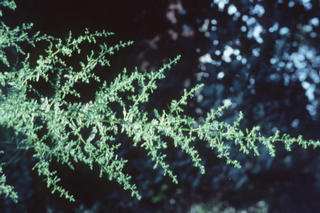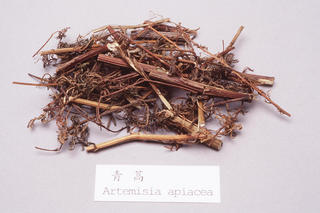Artemisia annua
Contents
Nomenclature
Other Names:
Historical Use of Artemisia annua
Artemisia annua in Traditional Chinese Medicine
Background
Nanqinghao ÄÏÇàÝï
Nenqinghao ÄÛÇàÝï
Chinese Name (pinyin): Qinghao
Chinese Name :
Common Name :Sweet Wormwood
Specific Name : Herba artemisiae annuae
Scientific Name:
Collection : The drug is collected in autumn at flowering, remove from the older stems and dried in the shade.
Description : Stems cylindrical, frequently branched at the upper part, 30 - 80cm long, 2 - 6mm in diameter, externally yellowish green or brownish yellow with lonitudinal ridges, texture slight hard, easily broken, fracture medullated in the central part. Leaves alternate, dark green or brownish green, rolled and crumpled, easily broken when whole, 3-pinnatipartite, the segments and the smaller segments oblong or long elliptical, pubescent on both surfaces, odour charateristically aromatic and taste slightly bitter.
Identification : To about 3g of the powder add 50ml of tehanol, heat under reflux for 1 hour, filter, evaporate the filtrate to dryness. Dissolve the residue in 5ml of ethanol and use it as the test solution. Prepare a reference drug solution of Radix Aristolochiae in the same way as described for the test solution. Dissolve aistolochic acid CRS in ethanol to produce a solution containing 0.5mg per ml as the reference solution. Carry out the method for thin layer chromatography (appendix Vl B), using silica gel G containing sodium carboxymethyl cellulose as the coating substance and benzene-methanol-glacial acetic acid (5:0:8:0.1) as the mobile phase. Apply separately 5µl of each of the above three solutions to the plate. After developing and removal of the plate, dry it in the air. Examine under day light and ultra-violet light (365nm). The spots in the chromatogram obtained with the test solution correspond in position and color to the spot in the chromatogram obtained with the reference solution and reference drug solution.
Processing : Eliminate foreign matter, spray with water, soften briefly, cut inot section and dry in the sun.
Action : To remove summer-heat, to relieve consumptive fever, and to stop malarial attacks.
Indication : fever caused by summer-heat; afternoon fever in deficiency of yin or in consumptive diseases; malaria with chills and fever; jaundice
Precautions :
Dosage : 4.5 to 9 g.
Storage : Preserve in a cool and dry place.
Nomenclature
Other Names:
Historical Use of Artemisia annua
Artemisia annua in Traditional Chinese Medicine
Background
Nanqinghao ÄÏÇàÝï
Nenqinghao ÄÛÇàÝï
Chinese Name (pinyin): Qinghao
Chinese Name :
Common Name :Sweet Wormwood
Specific Name : Herba artemisiae annuae
Scientific Name:
Collection : The drug is collected in autumn at flowering, remove from the older stems and dried in the shade.
Description : Stems cylindrical, frequently branched at the upper part, 30 - 80cm long, 2 - 6mm in diameter, externally yellowish green or brownish yellow with lonitudinal ridges, texture slight hard, easily broken, fracture medullated in the central part. Leaves alternate, dark green or brownish green, rolled and crumpled, easily broken when whole, 3-pinnatipartite, the segments and the smaller segments oblong or long elliptical, pubescent on both surfaces, odour charateristically aromatic and taste slightly bitter.
Identification : To about 3g of the powder add 50ml of tehanol, heat under reflux for 1 hour, filter, evaporate the filtrate to dryness. Dissolve the residue in 5ml of ethanol and use it as the test solution. Prepare a reference drug solution of Radix Aristolochiae in the same way as described for the test solution. Dissolve aistolochic acid CRS in ethanol to produce a solution containing 0.5mg per ml as the reference solution. Carry out the method for thin layer chromatography (appendix Vl B), using silica gel G containing sodium carboxymethyl cellulose as the coating substance and benzene-methanol-glacial acetic acid (5:0:8:0.1) as the mobile phase. Apply separately 5µl of each of the above three solutions to the plate. After developing and removal of the plate, dry it in the air. Examine under day light and ultra-violet light (365nm). The spots in the chromatogram obtained with the test solution correspond in position and color to the spot in the chromatogram obtained with the reference solution and reference drug solution.
Processing : Eliminate foreign matter, spray with water, soften briefly, cut inot section and dry in the sun.
Action : To remove summer-heat, to relieve consumptive fever, and to stop malarial attacks.
Indication : fever caused by summer-heat; afternoon fever in deficiency of yin or in consumptive diseases; malaria with chills and fever; jaundice
Precautions :
Dosage : 4.5 to 9 g.
Storage : Preserve in a cool and dry place.
Synonymns for Artemisia annua
Patent Medicines and Medicines with Multiple Ingredients that include Artemisia annua
Pharmaceutical Information
Chemical Constituents
Evidence or the Use of Artemisia annua in the Treatment of Epilepesy
Basic Science
Animal Studies
Cohort, Case-Control and Non-Randomized Trials
Randomized Controlled Trials
Meta-Analysis
1st Five Results: pubmed search
Silvano S Twinomujuni, Esther C Atukunda, Jackson K Mukonzo, Musinguzi Nicholas, Felicitas Roelofsen, Patrick E Ogwang
Evaluation of the effects of Artemisia Annua L. and Moringa Oleifera Lam. on CD4 count and viral load among PLWH on ART at Mbarara Regional Referral Hospital: a double-blind randomized controlled clinical trial.
AIDS Res Ther: 2024, 21(1);22
[PubMed:38627722]
[WorldCat.org]
[DOI]
(I e)
Meng-Yue Wang, Hui-Hua Wan, Li Xiang, Yu-Ting Pu, Qing-Gang Yin, Ran-Ran Gao, Yu-Hua Shi, Lan Wu
[Simultaneous determination of seven artemisinin-related compounds in Artemisia annua by UPLC-QQQ-MS/MS].
Zhongguo Zhong Yao Za Zhi: 2024, 49(5);1260-1265
[PubMed:38621973]
[WorldCat.org]
[DOI]
(P p)
Juan Wang, Tingting Shi, Hui Wang, Meng Li, Xiaobo Zhang, Luqi Huang
##Title##
Plants (Basel): 2024, 13(7);
[PubMed:38611578]
[WorldCat.org]
[DOI]
(P e)
Flavio Polito, Mattia Di Mercurio, Silvia Rizzo, Maura Di Vito, Maurizio Sanguinetti, Andrea Urbani, Francesca Bugli, Vincenzo De Feo
##Title##
Plants (Basel): 2024, 13(7);
[PubMed:38611496]
[WorldCat.org]
[DOI]
(P e)
J Robert McCorkle, Rebecca Ahn, Connie D Cao, Kristen S Hill, Charles S Dietrich, Jill M Kolesar
Antineoplastic Drug Synergy of Artesunate with Navitoclax in Models of High-Grade Serous Ovarian Cancer.
Cancers (Basel): 2024, 16(7);
[PubMed:38610999]
[WorldCat.org]
[DOI]
(P e)

